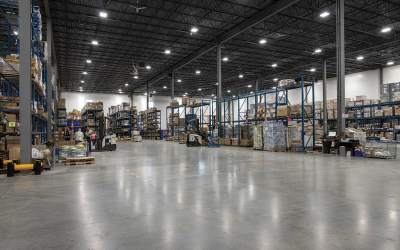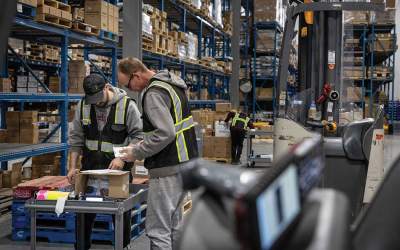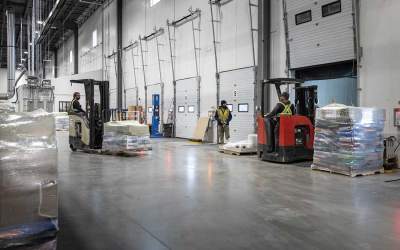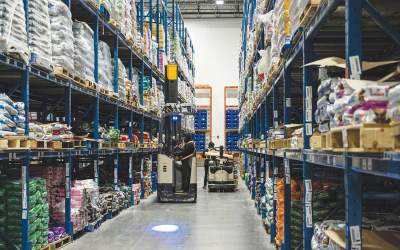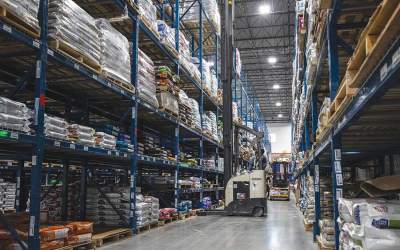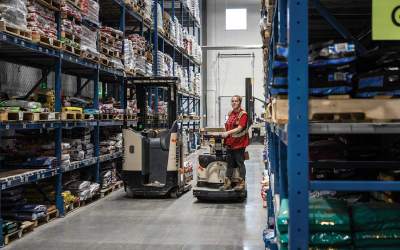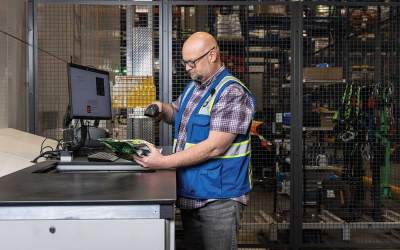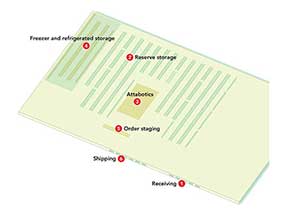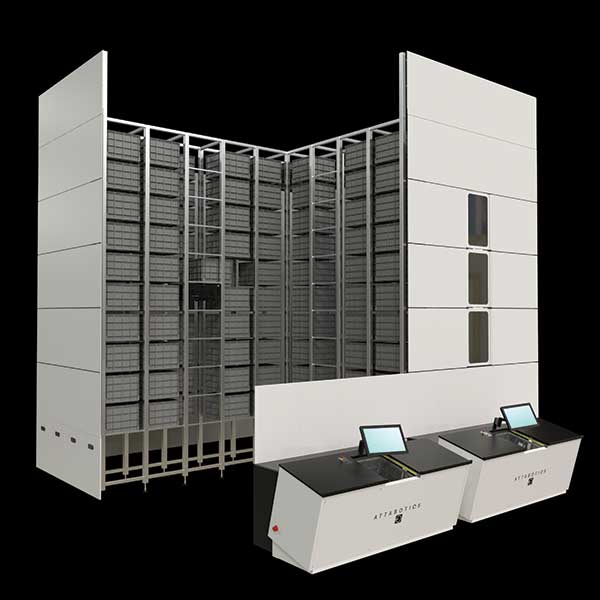Pan Pacific Pet learns new trick
In Canada, a new robotics goods-to-person fulfillment system is transforming distribution at one of the largest suppliers of pet-related products.
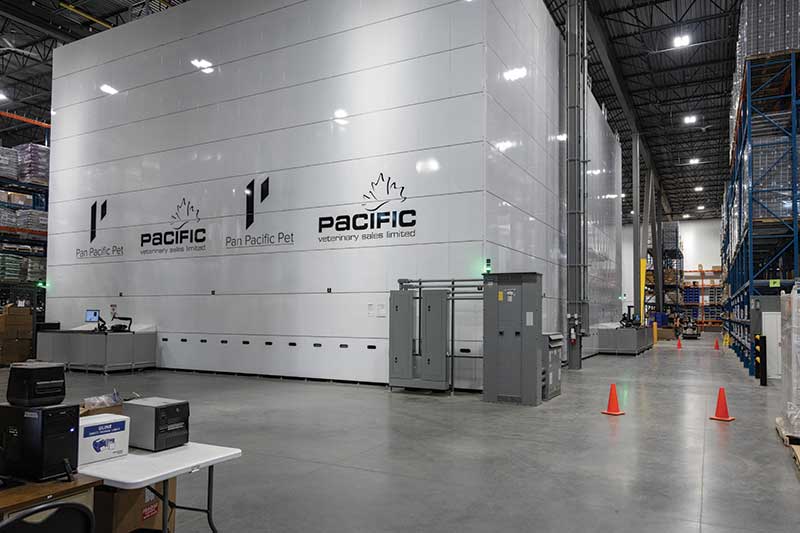
If you feel like everyone you know got a new pet during Covid, you wouldn’t be entirely wrong. The Washington Post reports that “more than 23 million American households—nearly 1 in 5 nationwide—adopted a pet during the pandemic, according to the American Society for the Prevention of Cruelty to Animals (ASPCA). But, the pet phenomenon wasn’t limited to the United States. Canadians also adopted new pets in record numbers.
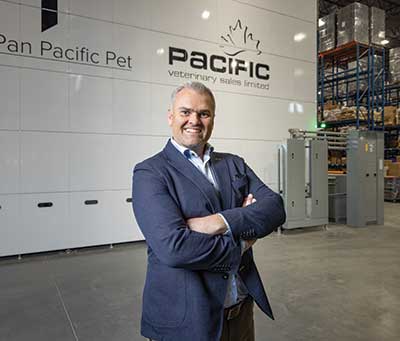
“When Covid hit, so much changed in our industry,” says Phil Klaassen, CEO of Pan Pacific Pet, a distributor of pet supplies with headquarters in Vancouver, British Columbia. “Canadians added 1 million new pets to their homes,” he says, driving additional growth to a business that was already an industry leader. “In the past seven years, we added in the neighborhood of 70 new vendors and 7,000 new items,” Klaassen adds. “We have the most sales reps per capita in the country.”
That growth led to Pan Pacific Pet’s need for a new, highly automated 120,000-square-foot distribution center near Calgary. The facility replaced an existing 67,000-square-foot manual building and adds capacity to a network that includes a second 57,000-square-foot facility outside of Vancouver. Pan Pacific Pet also announced plans to build a new, bigger facility near Vancouver that will incorporate freezer space.
The new facility accomplishes two important things: First, it enables Pan Pacific Pet to provide seamless customer service and a high level of representation to its vendors. “One of my mantras is that when one of our retailers has a problem, I want them to feel as if they’re dealing with Costco, where everything is taken care of,” Klaassen says. Even though the Canadian geography is vast, the distributor delivers next-day service to 85% of its business, serving the rest with two-day service.
The heart of the new facility is a unique robotic goods-to-person order fulfillment system (Attabotics) developed in Calgary. “For us, there’s a point of pride that we can work with a Canadian company that’s so advanced,” notes Trevor McBratney, executive vice president of Pan Pacific Pet. Beyond the home field advantage, the system brought a significant increase in throughput to the facility. “In our old facility, we were picking about 60 lines per hour using wire-guided stock pickers in very narrow aisles,” McBratney says. “With this new system, we can pick up to 400 lines per hour.”
The system initially features 20 robots to manage 9,000 SKUs, representing about half of the SKUs offered by Pan Pacific Pet. The other 9,000 SKUs are non-conveyables, either because of their size, such as large bags of pet food, or because they’re fragile, such as aquariums.
Along with increased throughput, the robotic picking system enables Pan Pacific Pet to offer new services to the market, such as micro-fulfillment services for other distributors and retailers. “This gives us the flexibility to grow our business in new ways, and engage our team and customers in new ways,” says Lou Nagy, operations and integration manager at the Calgary facility. “As a very customer-centric company, we can demonstrate that we’re open to new ideas and doing things in new ways.”
Growing the business and capabilities
Company president Tom McBratney founded Pan Pacific Pet in 1986 “with a desk made out of an old door held up by two sawhorses.” Nearly 38 years later, the family-owned company has grown into one of Canada’s leading pet specialty distributors, serving an estimated 1,100 customers—from big box retailers to mom-and-pop pet stores to veterinarians, breeders and shelters.
A company video tells the story of the company’s growth through the evolution of its distribution facilities. The first warehouse measured just 4,000 square feet. That was followed by a 12,200-square-foot facility in 1988 and the current two-facility strategy by 1994. Over time, the facilities in those areas expanded in size to 67,000 square feet in Calgary and 57,000 square feet in Vancouver, for a total of 120,000 square feet of distribution space.
“Not everyone in our business would want to operate two facilities given the size of the population we serve, but many of our retailers don’t have backrooms for extra stock,” Klaassen says. “They may need two shipments a week. Given the geography we have to cover, you just can’t do that without two facilities.”
Another innovation: In 2011, Pan Pacific Pet added freezer capacity in its facilities to handle raw pet foods, including a 10,000-square-foot, 30-foot-tall freezer in Calgary. “The ability to handle and distribute frozen product has set us apart and allowed us to expand into new innovations in pet food, such as raw, chilled and frozen foods,” Klaassen says.
How Attabotics works
When it comes to the automation of goods-to-person picking, the last decade witnessed a revolution with the introduction of a new group of goods-to-person picking technologies that are compact, use less steel and take a different approach to solving the problem.
AutoStore, OPEX and Symbotic are the best-known examples. Now, you can add the seven-year-old Canadian robotics company Attabotics to that list.
The solution deserves a little explanation because it’s different. According to Attabotics, the design was based on the way leafcutter ants organize their colonies. If you watch videos of the system, Attabotics combines a shuttle-like robot for bin movement.
Some of that movement takes place on top of a grid like AutoStore; however the robots can also travel vertically up and down columns that are strategically located within the system to provide access to putaway and retrieve inventory bins.
In the basement area of the system, the robots stage and sequence bins for delivery to picking stations. One of the benefits: A grocer filling orders for in-store pickup or home delivery can sequence the heavy items that will go in the bottom of a bag or box first and the lighter items that will go on top last.
The grid is organized around arrays of five columns: One is a vertical travel column that, in turn, allows every robot to access four bins on every level—one bin from each of the other four columns in the array.
Most inventory will be stored in multiple bins and across more than one array of columns. That way, when an order drops, the robot is directed to the nearest array of columns where a bin with that inventory is stored. That reduces the time it takes to retrieve and deliver a bin to a workstation.
Every column array always has at least one empty storage location so a robot can putaway the bin it is carrying before moving to its next assignment. The bins sit on a shelf rail, which allows the robot to pull the one onto its top and then secure it so it doesn’t slide off as the robot travels to its next location.
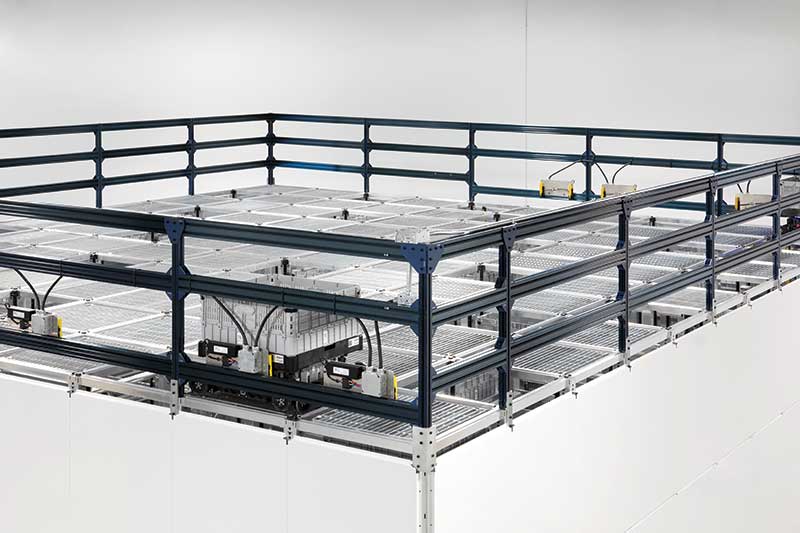
Bins measure 2-feet square and are 16-inches tall, with a payload capacity of up to 100 pounds. Bins can be divided into as many as 16 compartments to accommodate SKUs of different sizes. At Pan Pacific Pet, the system will initially feature 20 robots that will manage 9,000 SKUs and present 400 bins per hour to order selectors.
The solution is also energy efficient. Instead of lithium batteries that go out of service to charge, the robots feature super capacitors charged by busbars as they travel up and down the columns.
When the system is operational, robots begin and end their day on top of the grid with an inventory bin onboard. In that way, each robot is also recognized as a storage location in the system. When an order drops from the warehouse management system, it is assigned to the robot nearest an inventory bin.
If the order doesn’t call for inventory the robot is already carrying, it travels down one of the columns and puts it away in the open slot. It then retrieves the required bin and travels to the basement area where it waits for an open workstation. Once the required inventory is picked, the robot travels back to the top of the grid if it doesn’t have another assignment in between, and the process starts over again.
In the company history, McBratney says in the early days he didn’t always have a plan, and he was unfamiliar with retail practices like markups and markdowns. So, he focused on customer service and then hired and empowered employees with the skills needed to help him grow the company.
Klaassen, the company CEO, is an example of that approach. Hired in 1992 when he was in his 20s, he learned the business over time and eventually became CEO. Today, promoting from within is part of the company DNA.
“Our IT team has five people, and three of them started in the warehouse, including our chief technology officer,” Klaassen says. “We helped them grow and promoted them because of their capabilities.”
Today, Pan Pacific Pet continues to focus on serving the vendors whose product it distributes. “It’s easy to look at a distributor as a necessity between a vendor and their customers,” Klaassen says. “We want to be a cherished provider of important services that our vendors and their customers need.”
Automating a new facility
As populations change, people are having fewer children and aren’t having them as young. As we learned during the pandemic, many people are putting their energy, love and money into their pets. Those demographic changes and growth of the pet market led to the need for the new facility.
“To differentiate us from our competition, we had to develop a supply chain that allowed us to speed things to our retailers in a consistent and timely manner because they don’t have warehouses to supply their stores,” Klaassen says. “That’s a big reason why robotic storage and picking became part of our strategy.”
Adding robotics isn’t the first time the company adopted technology for a competitive advantage, Klaassen adds. About 10 years ago, Pan Pacific Pet designed an iPad app because so many of its customers didn’t have access to technology and were faxing in orders.
The app allowed them to enter orders into the iPad and hit send. The app is still used by many customers today. Pan Pacific Pet also developed a proprietary warehouse management system (WMS) to run its order management and warehouse operations.
Its old facilities relied on conventional materials handling solutions. Picking was from pallet rack to pallet jacks at the floor level or wire-guided stock pickers for inventory that was stored up high. Order selectors had to traverse the building and were picking around 60 lines per hour. “We wanted to get all of the efficiencies that we could and increase our throughput,” Klaassen says.
The investigation for a new technology began about a year before Covid, and included shuttle systems, autonomous mobile robots and other robotics goods-to-person solutions before the search brought them to a robotics company in their backyard.
“We liked the fact that they do everything in Calgary, where we didn’t have to go far to visit their facilities,” Klaassen says. From an operational view, “we liked that every bin in their system is as accessible as every other bin,” he says. “We put their system through the paces and they proved to us that we could significantly increase our lines per hour.”
Located in the middle of the new facility, the system is designed to serve 400 bin presentations per hour across four workstations. The workstations are flexible: They can be used for replenishment, picking and cycle counting depending on the process most needed at the time. Klaassen expects that two order selectors will be able to fill the same number of orders as the six to seven order selectors used in manual operations.
In addition, the building is largely energy self-sufficient thanks to an array of 1,600 solar panels on the roof. The solar system takes advantage of the fact that Calgary has the second most days of sun in Canada.
The Attabotics system runs during the day. The freezers also run off the solar source during the day and then switch to the grid at night. Fast smart chargers are in place to charge lift trucks during breaks.
Taking Pan Pacific Pet forward
Transitioning from conventional operations to a highly automated solution takes time, often more than anticipated during the planning stage.
One part of that is training. Initially, Pan Pacific Pet plans on picking discreet orders so one operator is picking items to just one outbound container; as operators become more comfortable with the system, they’ll transition to picking into up to four outbound containers to get more efficiency.
The second has been regulatory and logistical. “Every region has its own permitting processes, and you don’t always know what you need until the engineers show up,” Klaassen says. “We didn’t know we were going to need a fire pump for the sprinkler system and a year later, the fire pump is just arriving.”
Logistical bumps in the road, like waiting on the delivery of the fire pump, slowed down the installation. The lesson learned: “You need to have solutions in place to continue to operate your business past the dates you think you might hit,” Klaassen says. “Fortunately, when we planned the facility, we had enough space and racking to continue to operate manually until the automation is fully operational.”
Despite the delays, Klaassen says the system is already paying dividends, even if they are soft improvements. The solar panels are expected to produce 40% more power than is needed for operations during the summer, which can be sold, and even in winter Calgary gets plenty of sun when it’s not snowing.
The other may be how the investment in automation and sustainability positions Pan Pacific Pet in the market. “The combination is creating interest in our company and has already helped us get an additional 10 to 20 new vendors,” Klaassen says. “They tell us that if we’re that forward thinking, they want to be with us.”

Article Topics
Attabotics News & Resources
Pan Pacific Pet learns new trick Pan Pacific Pet’s new distribution center: Building operations around automated order fulfillment Attabotics, which offers a 3D robotics solution, secures $71.7 million in additional funding Körber announces Asia partnership with Attabotics Attabotics appoints Cyra Richardson, former Microsoft and Amazon executive, as CTO and CPO Attabotics partners with AltaML and Amii to bolster AI capabilities Attabotics and FoodX Technologies partner on joint microfulfillment solution for e-grocery More AttaboticsLatest in Materials Handling
Geek+ and System Teknik deploy PopPick solution for pharmacy group Med24.dk Beckhoff USA opens new office in Austin, Texas Manhattan Associates selects TeamViewer as partner for warehouse vision picking ASME Foundation wins grant for technical workforce development The (Not So) Secret Weapons: How Key Cabinets and Asset Management Lockers Are Changing Supply Chain Operations MODEX C-Suite Interview with Harold Vanasse: The perfect blend of automation and sustainability Consultant and industry leader John M. Hill passes on at age 86 More Materials HandlingAbout the Author
Subscribe to Materials Handling Magazine

Find out what the world's most innovative companies are doing to improve productivity in their plants and distribution centers.
Start your FREE subscription today.
April 2024 Modern Materials Handling

Latest Resources


